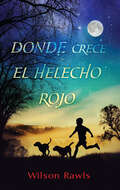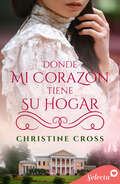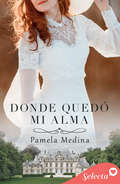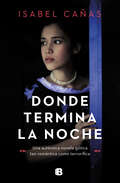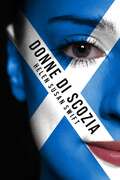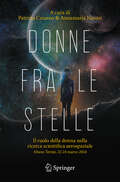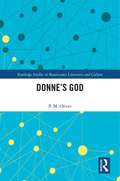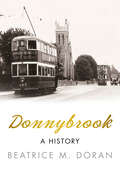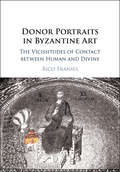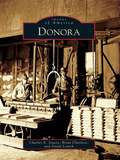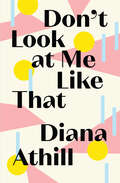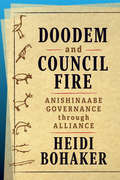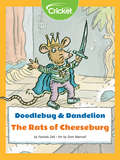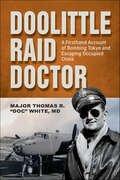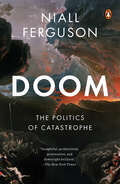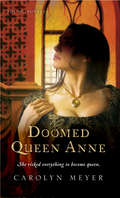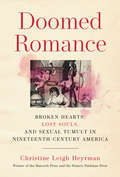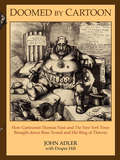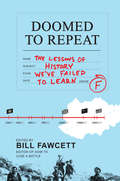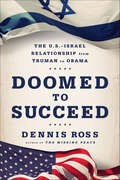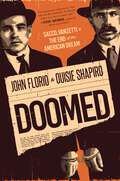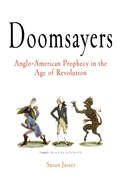- Table View
- List View
Donde crece el helecho rojo / Where the Red Fern Grows
by Wilson RawlsUN NIÑO, DOS PERROS, UNA GRAN AVENTURA. Billy siempre ha soñado con tener dos perros, así que cuando logra ahorrar suficiente dinero para tener dos cachorros —Viejo Dan y Annita—, se siente increíblemente feliz. Es cierto que corren tiempos difíciles, pero juntos recorrerán los montes Ozark y se convertirán en el mejor equipo de cacería del valle. La combinación de la fuerza de Viejo Dan, la inteligencia de Annita y la tenacidad de Billy parece invencible. La tragedia, sin embargo, los aguarda. Billy aprenderá que del dolor también puede nacer la esperanza. Donde crece el helecho rojo gustará a los lectores de todas las edades. Es un retrato fiel del poderoso lazo que existe entre los grandes amigos.
Donde mi corazón tiene su hogar (Minstrel Valley #Volumen 23)
by Christine CrossProvenían de mundos distintos: ella de la rígida sociedad inglesa, él del país de la libertad. La búsqueda sobre el pasado común de ambos los llevará a descubrir la posibilidad de un futuro juntos por amor. Lady Helena Melham posee un antiguo medallón ligado a una romántica leyenda. Su amor por las antigüedades y su gran curiosidad la llevarán a viajar desde Minstrel Valley a Boston para descubrir la verdad sobre la joya y la relación de esta con su familia. A su llegada encontrará un país sumergido en la preocupación de una guerra cruenta, en la que no hay espacio para el amor y sí para el odio. Sin embargo, la búsqueda de la historia del medallón le demostrará que, a través de los siglos, el amor siempre ha vencido al odio. Brayden Scott había regresado de la guerra convaleciente y sumido en una profunda depresión a causa de lo vivido. En un intento por sacarlo de su postración, su madre le encomienda acompañar a unajoven aristócrata inglesa interesada en unos documentos antiguos. Verse reducido a la condición de perro faldero de la que supone es una dama caprichosa no le agrada en absoluto, y está dispuesto a demostrárselo a lady Helena. Aunque, quizá, el destino tiene una lección que enseñarle.
Donde quedó mi alma
by Pamela Medina¿Puede una joven institutriz hacerle frente al pesar de un hombre sumido en la tristeza? ¿Puede un hombre volver a amar después de perderlo todo? Londres, 1877. Miss Emily Morgan, joven institutriz de la Governess Regency, finaliza con honores su formación y se prepara para ejercer su profesión. Cuando Miss Claire Foster, fundadora de la agencia, la convoca para un puesto de trabajo en Hampton House, Emily solo puede pensar en dar el sí. Sin embargo, la Governess Regency no la ha preparado para lidiar con los estigmas del dolor. Allí, en medio de conflictos, deberá aprender a sortear las exigencias de Lord Alex Hampton, conde de Lutton, viudo y padre de Elizabeth, una hija única que perdió la capacidad de caminar en un fatídico accidente, el mismo hecho en el que su madre perdió la vida. La niña pasa sus días postrada en una cama, privada decasi todo contacto con la realidad. Solo con el encanto de la pequeña pupila, y su propio temple, Emily granjea los obstáculos que Hampton House le depara. A pesar del dolor por las pérdidas, Alex Hampton logra recuperar su esperanza gracias a Emily y al amor que entre ellos nace. Sin embargo, cuando creían haber superado todo, distintos acontecimientos amenazan con separarlos. ¿Podrá Alex recuperar el amor de Emily? ¿Podrá Emily retornar a Hampton House, lugar donde dejó su alma?
Donde termina la noche
by Isabel CañasLa novela gótica mexicana se aúna con la mejor tradición de Rebeca en esta novela de suspense sobrenatural, ambientada en una remota hacienda durante los años de la guerra de independencia mexicana. El padre de Beatriz murió injustamente ajusticiado por alta traición y su hogar fue destruido. Cuando el atractivo Rodolfo Solórzano pide su mano, Beatriz decide ignorar los rumores que envuelven la muerte de su primera mujer y acepta sin dudarlo, convencida de que la seguridad económica y la posibilidad de alejarse de la ciudad y viajar hasta su rica hacienda en el campo, le harán olvidar la tragedia que ha vivido su familia. Pero la hacienda de San Isidro no es exactamente el refugio que había imaginado y cuando Rodolfo regresa a la capital y la deja sola en esa mansión aislada, las visiones y las voces empiezan a envolver a Beatriz, su sueño, su espacio, su vida. ¿Qué ocurrió realmente con la primera señora Solórzano? ¿Por qué la hermana de Rodolfo, Juana, se ríe de los miedos de Beatriz pero actúa de una manera tan extraña por la noche? Lo único de lo que Beatriz está segura es de que algo ocurre en la hacienda de San Isidro y que solo ella puede salvarse. La crítica ha dicho:«Un relato gótico de amor condenado y de espíritus vengativos.»The Washington Post «Cañas conoce claramente el género y el resultado es una brillante contribución a esta nueva generación de narrativa gótica poscolonial. Los lectores no deben perdérsela.»Publishers Weekly «Exuberante, hermosa, se merece absolutamente que la comparen con Rebeca. Una lectura esencial en este renacer del género gótico.»CrimeReads «Si te gusta el género gótico y te apetece una heroína con más potencia y una historia con garra, Donde termina la noche es el libro que estabas buscando.»Mystery
Donegal Folk Tales
by Joe BrennanDonegal has a rich heritage of myths and legends which is uniquely captured in this collection of traditional tales from the county. Discover the trails where Balor of the Evil Eye once roamed, the footprint left by St Colmcille when he leapt to avoid a demon and the places where ordinary people once encountered devils, ghosts, and fairies. In a vivid journey through Donegal’s varied landscape, from its spectacular rugged coast line to the majestic mountains of Errigal and Muckish, and on to the rich farmland of the east, local storyteller Joe Brennan takes the reader to places where legend and landscape are inseparably linked.
Donne di Scozia
by Lara Carpinelli Helen Susan SwiftDonne di Scozia è un viaggio nel tempo attraverso la storia scozzese per svelare l’importante ruolo svolto dalle donne. Dalle più umili a quelle straordinarie, le donne scozzesi sono state in prima fila e sullo sfondo degli eventi: le pescivendole, le combattenti, le grandi scrittrici, le giacobite, le martiri e le operaie. Senza di loro, la Scozia non sarebbe esistita. Goditi questo grande viaggio dai secoli bui al XXI secolo e incontra le donne che sono state la forza motrice di una nazione piccola ma dinamica.
Donne fra le stelle: Il ruolo della donna nella ricerca scientifica aerospaziale, Abano Terme 22- 24 marzo 2024
by Patrizia Caraveo Annamaria NassisiIl libro raccoglie le relazioni presentate alla terza edizione del convegno &“Donne fra le stelle&” che si è svolto ad Abano Terme dal 22 al 24 marzo, 2024. Scienziate e ricercatrici provenienti dai principali istituti, centri di ricerca ed industrie europee si raccontano, come donne e come professioniste, attraverso un linguaggio accessibile e coinvolgente. Il libro offre una visione completa dei problemi e delle opportunità che si trovano ad affrontare nel campo dell&’astrofisica, delle scienze e delle tecnologie spaziali. &“Donne fra le stelle&” è un&’associazione nata dal desiderio di illustrare le meraviglie del cosmo e delle tecnologie spaziali al grande pubblico attraverso la voce di astronaute, astrofisiche, geofisiche, ingegnere aerospaziali e ricercatrici, per rendere protagoniste le donne sottolineandone l&’impegno e i risultati in un ambito scientifico/industriale, dove è ancora nettamente prevalente la presenza maschile. L&’obiettivo dell&’associazione è stimolare i giovani, soprattutto le ragazze, a scegliere le materie STEM (Science, Technology, Engineering e Mathematics) nel loro percorso di studi, evidenziando anche come lo spazio sia diventato un ambiente multidisciplinare. Per questo &“Donne fra le stelle&” organizza simposi itineranti su tutto il territorio nazionale con la collaborazione dei più importanti centri di ricerca e industrie a livello nazionale e internazionale come INAF (Istituto Nazionale di Astrofisica), ASI (Agenzia Spaziale Italiana), ESA (European Space Agency), e NASA e delle industrie come Thales Alenia Space, Telespazio, e tante PMI e start-up.
Donne’s God (Routledge Studies in Renaissance Literature and Culture)
by P.M. OliverHis contemporaries recognised John Donne (1572-1631) as a completely new kind of poet. He was, wrote one enthusiast, ‘Copernicus in Poetrie’. But in the winter of 1614-15 Donne abandoned part-time versification for full-time priestly ministry, quickly becoming one of the most popular preachers of his time. While his verse has never been short of modern admirers, his sermons have recently begun to receive their full share of serious attention. Yet there exists almost no theologically-informed criticism to assist readers with navigating, let alone appreciating, the intricacies of Donne’s religious thinking. The need for such criticism is especially urgent since many readers approach his writing today with little previous knowledge of Christian doctrine or history. This book supplies that deficiency. Starting from the assumption that theology is inevitably the product of the human imagination, a perception that is traced back to major early Christian writers (and something that Donne implicitly acknowledged), it probes the complex amalgam that constituted his ever-shifting vision of the deity. It examines his theological choices and their impact on his preaching, analysing the latter with reference to its sometimes strained relationship with Christian orthodoxy and the implications of this for any attempt to determine how far Donne may legitimately be viewed as a mouthpiece for the Jacobean and Caroline Church of England. The book argues that the unconventionality that characterises his verse is also on display in his sermons. As a result it presents Donne as a far more creative and risk-taking religious thinker than has previously been recognised, especially by those determined to see him as a paragon of conventional Christian orthodoxy.
Donnybrook: A History (Ireland in Old Photographs)
by Beatrice M. DoranDonnybrook is one of the most iconic areas of South Dublin, a prosperous and peaceful suburb that is well-known as the being the heartland of Leinster Rugby. It derived its name, however, from the violence and carousing that were a regular feature of the area in the 1800s, and this book tells the story of the development and the journey from these inauspicious beginnings to its current form through a series of rare and beautifully produced photographs.
Donor Portraits in Byzantine Art: The Vicissitudes of Contact between Human and Divine
by Rico FransesThis book explores the range of images in Byzantine art known as donor portraits. It concentrates on the distinctive, supplicatory contact shown between ordinary, mortal figures and their holy, supernatural interlocutors. The topic is approached from a range of perspectives, including art history, theology, structuralist and post-structuralist anthropological theory, and contemporary symbol and metaphor theory. Rico Franses argues that the term 'donor portraits' is inappropriate for the category of images to which it conventionally refers and proposes an alternative title for the category, contact portraits. He contends that the most important feature of the scenes consists in the active role that they play within the belief systems of the supplicants. They are best conceived of not simply as passive expressions of stable, pre-existing ideas and concepts, but as dynamic proponents in a fraught, constantly shifting landscape. The book is important for all scholars and students of Byzantine art and religion.
Donora
by Charles E. Stacey Brian Charlton David LonichThe industrial community of Donora was founded in 1901 on a bend of the Monongahela River, 30 miles south of Pittsburgh. The founding of Donora was the result of social, political, and economic interaction among elite and powerful capitalists. Andrew and Richard Mellon partnered with William H. Donner and Henry C. Frick to create the Union Improvement Company and build a mill, developing the surrounding municipality. In less than a year, the population of Donora quickly boomed from an original 12 residents to more than 4,000 inhabitants. The opportunity for employment drew people from all over the United States and Europe, generating a diverse community. Regardless of differences, the races, religions, and ethnic groups that settled in Donora shared a common value system based on education, hard work, and devotion to faith and family.
Donovan's Devils: OSS Commandos Behind Enemy Lines—Europe, World War II
by Albert LulushiThe stirring, little-known story of the forerunners to today's Special Forces. The OSS--Office of Strategic Services--created under the command of William Donovan, has been celebrated for its cloak-and-dagger operations during World War II and as the precursor of the CIA. As the "Oh So Social," it has also been portrayed as a club for the well-connected before, during, and after the war. Donovan's Devils tells the story of a different OSS, that of ordinary soldiers, recruited from among first- and second-generation immigrants, who volunteered for dangerous duty behind enemy lines and risked their lives in Italy, France, the Balkans, and elsewhere in Europe. Organized into Operational Groups, they infiltrated into enemy territory by air or sea and operated for days, weeks, or months hundreds of miles from the closest Allied troops. They performed sabotage, organized native resistance, and rescued downed airmen, nurses, and prisoners of war. Their enemy showed them no mercy, and sometimes their closest friends betrayed them. They were the precursors to today's Special Forces operators. Based on declassified OSS records, personal collections, and oral histories of participants from both sides of the conflict, Donovan's Devils provides the most comprehensive account to date of the Operational Group activities, including a detailed narrative of the ill-fated Ginny mission, which resulted in the one of the OSS's gravest losses of the war. Skyhorse Publishing, as well as our Arcade imprint, are proud to publish a broad range of books for readers interested in history--books about World War II, the Third Reich, Hitler and his henchmen, the JFK assassination, conspiracies, the American Civil War, the American Revolution, gladiators, Vikings, ancient Rome, medieval times, the old West, and much more. While not every title we publish becomes a New York Times bestseller or a national bestseller, we are committed to books on subjects that are sometimes overlooked and to authors whose work might not otherwise find a home.
Don’t Look At Me Like That
by Diana AthillFrom the author of Somewhere Towards the End and Stet, the esteemed memoirist and editor Diana Athill’s only novel is an unflinching look at love and betrayal through the story of a young woman finding herself in 1950s London.England, in the mid-1950s. Meg Bailey has always aspired to live a respectable life. With her best friend, Roxane, she moves from secondary school to a preppy art college in Oxford. Under the watchful eye of Roxane’s mother, Mrs. Wheeler, the two girls flourish in Oxfordian society. But Meg constantly longs for more. Not content to stay in Oxford, she finds a job in London. Roxane stays behind and marries Dick, a man of Mrs. Wheeler’s choosing.As Meg’s independence grows, Dick suddenly appears in London for work. Representing a connection to her past, Meg and Dick’s friendship flourishes, blurring the lines of loyalty between what is and what was in a way that changes life for these three friends forever.As sharp and startling now as when it was written, Don’t Look at Me Like That is an unflinching and candid book of love and betrayal that encapsulates Diana Athill’s gift of storytelling at its finest.>
Doodem and Council Fire: Anishinaabe Governance through Alliance (Osgoode Society for Canadian Legal History)
by Heidi BohakerCombining socio-legal and ethnohistorical studies, this book presents the history of doodem, or clan identification markings, left by Anishinaabe on treaties and other legal documents from the seventeenth through the nineteenth centuries. These doodems reflected fundamental principles behind Anishinaabe governance that were often ignored by Europeans, who referred to Indigenous polities in terms of tribe, nation, band, or village – classifications that failed to fully encompass longstanding cultural traditions of political authority within Anishinaabe society. Making creative use of natural history, treaty pictographs, and the Ojibwe language as an analytical tool, Doodem and Council Fire delivers groundbreaking insights into Anishinaabe law. The author asks not only what these doodem markings indicate, but what they may also reveal through their exclusions. The book also ooutlines the continuities, changes, and innovations in Anishinaabe governance through the concept of council fires and the alliances between them. Original and path-breaking, Doodem and Council Fire offers a fresh approach to Indigenous history, presenting a new interpretation grounded in a deep understanding of the nuances and distinctiveness of Anishinaabe culture and Indigenous traditions.
Doodlebug & Dandelion: The Rats of Cheeseburg
by Meg MossDoodlebug has stage fright! When his tryout for the school play goes awry, he is embarrassed. His teacher notices Doodlebug’s artistic talent, though, and gives him a huge role in the play! Will he be able to get over his fear of the stage and let his true talent shine?
Doolittle Raid Doctor: A Firsthand Account of Bombing Tokyo and Escaping Occupied China
by Maj. Thomas WhiteThis account has never been published in it's complete form, remaining in private hands for more than 80 years
Doom: The Politics of Catastrophe
by Niall Ferguson"All disasters are in some sense man-made."Setting the annus horribilis of 2020 in historical perspective, Niall Ferguson explains why we are getting worse, not better, at handling disasters.Disasters are inherently hard to predict. Pandemics, like earthquakes, wildfires, financial crises. and wars, are not normally distributed; there is no cycle of history to help us anticipate the next catastrophe. But when disaster strikes, we ought to be better prepared than the Romans were when Vesuvius erupted, or medieval Italians when the Black Death struck. We have science on our side, after all. Yet in 2020 the responses of many developed countries, including the United States, to a new virus from China were badly bungled. Why? Why did only a few Asian countries learn the right lessons from SARS and MERS? While populist leaders certainly performed poorly in the face of the COVID-19 pandemic, Niall Ferguson argues that more profound pathologies were at work--pathologies already visible in our responses to earlier disasters.In books going back nearly twenty years, including Colossus, The Great Degeneration, and The Square and the Tower, Ferguson has studied the foibles of modern America, from imperial hubris to bureaucratic sclerosis and online fragmentation.Drawing from multiple disciplines, including economics, cliodynamics, and network science, Doom offers not just a history but a general theory of disasters, showing why our ever more bureaucratic and complex systems are getting worse at handing them.Doom is the lesson of history that this country--indeed the West as a whole--urgently needs to learn, if we want to handle the next crisis better, and to avoid the ultimate doom of irreversible decline.
Doomed Queen Anne: A Young Royals Book (Young Royals #3)
by Carolyn MeyerThough born without great beauty, wealth, or title, Anne Boleyn blossomed into a captivating woman. She used her wiles to win the heart of England's most powerful man, King Henry VIII, and persuade him to defy everyone--including his own wife--to make her his new queen. But Anne's ambition was her fatal flaw. This is the true story of the girl everyone loved to hate.Carolyn Meyer's engrossing third novel in the award-winning Young Royals series tells Anne's fascinating story in her own voice--from her life as an awkward girl to the dramatic moments before her death.
Doomed Romance: Broken Hearts, Lost Souls, and Sexual Tumult in Nineteenth-Century America
by Christine Leigh HeyrmanFrom the winner of the Bancroft Prize and the Francis Parkman Prize in History, a lost episode rediscovered after almost two hundred years; a thwarted love triangle of heartbreak--two men and a woman of equal ambition--that exploded in scandal and investigation, set between America's Revolution and its Civil War, revealing an age in subtle and powerful transformation, caught between the fight for women's rights and the campaign waged by evangelical Protestants to dominate the nation's culture and politics.At its center--and the center of a love triangle--Martha Parker, a gifted young New England woman, smart, pretty, ambitious, determined to make the most of her opportunities, aspiring to become an educator and a foreign missionary.Late in 1825, Martha accepted a proposal from a schoolmaster, Thomas Tenney, only to reject him several weeks later for a rival suitor, a clergyman headed for the mission field, Elnathan Gridley. Tenney's male friends, deeply resentful of the new prominence of women in academies, benevolent and reform associations, and the mission field, decided to retaliate on Gridley's behalf by sending an anonymous letter to the head of the foreign missions board impugning Martha's character. Tenney further threatened Martha with revealing even more about their relationship, thereby ruining her future prospects as a missionary. The head of the board began an inquiry into the truth of the claims about Martha, and in so doing, collected letters, diaries, depositions, and firsthand witness accounts of Martha's character. The ruin of Martha Parker's hopes provoked a resistance within evangelical ranks over womanhood, manhood, and, surprisingly, homosexuality, ultimately threatening to destroy the foreign missions enterprise.
Doomed by Cartoon: How Cartoonist Thomas Nast and The New York Times Brought down Boss Tweed and His Ring of Thieves
by John Adler Draper HillThe timely, true story of Thomas Nast, the granddaddy of political satire who destroyed a corrupt regime in 19th century New York City—with cartoons. He was an unethical, bullying, and narcissistic politician; a blow-hard real estate magnate and notorious swindler; a master manipulator who thrived off voter fraud, graft, and the collusion of his right-hand sycophants. This is the 1870s. The legendary William &“Boss&” Tweed, senator and third-largest landowner in New York City, is on a roll. He and his thieving minions have already duped the city out of an estimated two-billion dollars. It wasn&’t going to be easy exposing him. He controlled the press—except for the magazine, Harper&’s Weekly. And Harper&’s had an invaluable weapon against the humorless and seemingly invincible Tweed: Thomas Nast, an influential political cartoonist who, day by day, brought Tweed&’s corruption to light. With pen and ink, and a savage and righteous wink, Thomas Nast was determined to topple an empire. Told through Nast&’s scathing 160-plus serialized cartoons, the remarkable and unbelievable true story of Nast vs. Tweed was not only unprecedented for its day, but it set the tone for the battle between the freedom of the press and political malfeasance that resonates well into the twenty-first century.
Doomed to Repeat: The Lessons of History We've Failed to Learn
by Bill Fawcett“Those who forget history are doomed to repeat it.” And so we have. Time and again, mankind has faced down problems, but have often failed to take the hard-earned knowledge into the next battle. Doomed to Repeat is a collection of essays, edited by Bill Fawcett, that illuminates some of the problems we've faced repeatedly throughout history, including Islamic jihad, terrorism, military insurgencies, inflation and the devaluation of currency, financial disasters, ecological collapses, radical political minorities like the Nazis and Bolsheviks, and pandemics and epidemics like the Black Death. With more than 35 chapters of the Groundhog Days of world history, both infamous and obscure, Doomed to Repeat: The Lessons of History We've Failed to Learn is chock-full of trivia, history, and fascinating looks at the world’s repeated mistakes.
Doomed to Repeat?: Terrorism and the Lessons of History
by Sean BrawleyThis collection of scholarly essays explores the role of history in terrorism studies and today’s counterterrorism initiatives.In Doomed to Repeat?, scholars, policy makers, and other practitioners explore how a better understanding of the past can help us combat terrorism in the future. The first section establishes a broader context for discussion by examining the connections between history and Terrorism Studies. The second section presents the insights of non-historians who know the importance of historical perspective in understanding current events. Section Three provides case studies that explore the history of terrorism and politically motivated violence. Section Four concludes by placing concerns about terrorism in regional and foreign policy context. “This collection helps us advance our understanding of terrorism beyond simplistic and dichotomist assertions about “them” and “us.” Taken together, these essays highlight the importance of analyzing, rather than assuming.” —Chris Dixon, Professor, School of History, Philosophy, Religion, and Classics, The University of Queensland, Australia
Doomed to Succeed: The U.S.-Israel Relationship from Truman to Obama
by Dennis RossA necessary and unprecedented account of America's changing relationship with IsraelWhen it comes to Israel, U.S. policy has always emphasized the unbreakable bond between the two countries and our ironclad commitment to Israel's security. Today our ties to Israel are close—so close that when there are differences, they tend to make the news. But it was not always this way. Dennis Ross has been a direct participant in shaping U.S. policy toward the Middle East, and Israel specifically, for nearly thirty years. He served in senior roles, including as Bill Clinton's envoy for Arab-Israeli peace, and was an active player in the debates over how Israel fit into the region and what should guide our policies. In Doomed to Succeed, he takes us through every administration from Truman to Obama, throwing into dramatic relief each president's attitudes toward Israel and the region, the often tumultuous debates between key advisers, and the events that drove the policies and at times led to a shift in approach. Ross points out how rarely lessons were learned and how distancing the United States from Israel in the Eisenhower, Nixon, Bush, and Obama administrations never yielded any benefits and why that lesson has never been learned. Doomed to Succeed offers compelling advice for how to understand the priorities of Arab leaders and how future administrations might best shape U.S. policy in that light.
Doomed: Sacco, Vanzetti & the End of the American Dream
by Ouisie Shapiro John FlorioFrom John Florio and Emmy Award-winning writer Ouisie Shapiro comes a monumental YA nonfiction book about the heartbreaking case of Sacco and Vanzetti, two Italian immigrants who were wrongfully executed for murder.In the early 1920s, a Red Scare gripped America. Many of those targeted were Italians, Eastern Europeans, and other immigrants.When an armed robbery resulting in the death of two people broke headlines in Massachusetts, Nicola Sacco and Bartolomeo Vanzetti—both Italian immigrants—were quick to be accused.A heated trial ensued, but through it all, the two men maintained their innocence. The controversial case quickly rippled past borders as it became increasingly clear that Sacco and Vanzetti were fated for a death sentence. Protests sprang up around the world to fight for their lives.Learn the tragic history we dare not repeat in Doomed: Sacco, Vanzetti, and the End of the American Dream, an action-packed, fast-paced nonfiction book filled with issues that still resonate today.Praise for Doomed“A riveting true crime story—but who are the criminals? As relevant today as it was a century ago.” - Steve Sheinkin, author of Bomb and Fallout
Doomsayers
by Susan JusterThe age of revolution, in which kings were dethroned, radical ideals of human equality embraced, and new constitutions written, was also the age of prophecy. Neither an archaic remnant nor a novel practice, prophecy in the eighteenth century was rooted both in the primitive worldview of the Old Testament and in the vibrant intellectual environment of the philosophers and their political allies, the republicans. In Doomsayers: Anglo-American Prophecy in the Age of Revolution, Susan Juster examines the culture of prophecy in Great Britain and the United States from 1765 to 1815 side by side with the intellectual and political transformations that gave the period its historical distinction as the era of enlightened rationalism and democratic revolution.Although sometimes viewed as madmen or fools, prophets of the 1790s and early 1800s were very much products of a liberal commercial society, even while they registered their disapproval of the values and practices of that society and fought a determined campaign to return Protestant Anglo-America to its biblical moorings. They enjoyed greater visibility than their counterparts of earlier eras, thanks to the creation of a vigorous new public sphere of coffeehouses, newspapers, corresponding societies, voluntary associations, and penny pamphlets. Prophecy was no longer just the art of applying biblical passages to contemporary events; it was now the business of selling both terror and reassurance to eager buyers. Tracking the careers of several hundred men and women in Britain and North America, most of ordinary background, who preached a message of primitive justice that jarred against the cosmopolitan sensibilities of their audiences, Doomsayers explores how prophetic claims were formulated, challenged, tested, advanced, and abandoned. The stories of these doomsayers, whose colorful careers entertained and annoyed readers across the political spectrum, challenge the notion that religious faith and the Enlightenment represented fundamentally alien ways of living in and with the world.From the debates over religious enthusiasm staged by churchmen and the literati to the earnest offerings of ordinary men and women to speak to and for God, Doomsayers shows that the contest between prophets and their critics for the allegiance of the Anglo-American reading public was part of a broader recalibration of the norms and values of civic discourse in the age of revolution.
